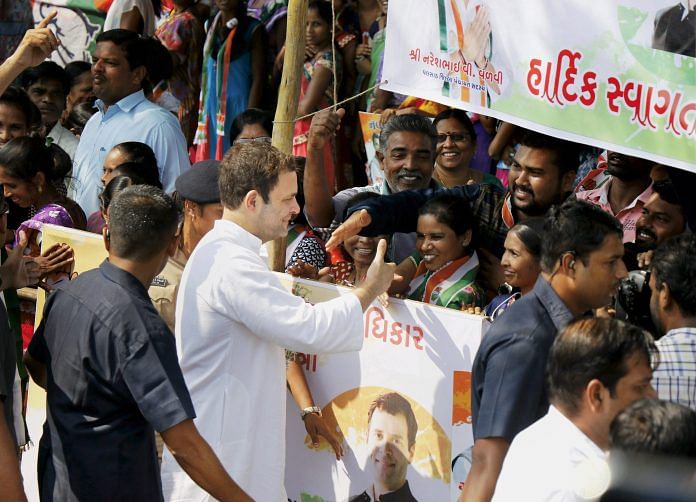Ahead of the crucial Gujarat elections, the Congress party has been actively seeking out powerful leaders of different caste communities. A prominent OBC strongman Alpesh Thakor of the BJP has defected to the Congress party, even as talks with the Patidar leader Hardik Patel are underway. Its complex caste formulations have given some hope to the beleaguered Congress party in Gujarat, which has been under the BJP rule for almost two decades.
Can Congress use caste to challenge BJP’s ‘Hindutva-Vikas’ in Gujarat elections? We bring sharp perspectives.
Much before Modi became Hindutva’s poster boy, he was the wizard of Gujarat’s caste chemistry
 Sheela Bhatt
Sheela Bhatt
Editor, National Affairs, NewsX
The caste card is one of the advantages the Congress possesses, but not exclusively. The BJP will use the caste card with as much vigour as it will use the Modi card.
The Congress’s problem is that Jignesh Mevani and Alpesh Thakore are not adding anything new to its 38.9 per cent vote share from 2012. Hardik Patel, on the other hand, is all about the “disgruntled BJP crowd”, but again, his forte is unabashed Patelism, and that’s both his strength and his weakness.
With new leaders in its camp, the Congress will have to handle a heterogeneous caste mela with panache. But it’ll be a tough ask, because unlike the BJP, where Amit Shah is a one-window power station, one isn’t sure who holds the baton in the Congress.
Much before Modi became Hindutva’s poster boy, he was the wizard of Gujarat’s caste chemistry. It was Modi and some Gujarat-based RSS stalwarts who used Patidar votes to bring down the Congress’s solidified Kshatriya-Harijan-Adivasi-Muslim support base in the early 1990s.
The case of Rajya Sabha MP Shambhuprasad Tundiya is an example of Modi-Shah’s caste concoction. It’s difficult to figure out if he is an MP due to his Hindu credentials — he heads the Sant Savgun Samadhisthan religious seat in Zanzarka — or because he represents the Vankars, a sub-caste of Dalits. By sending him to the Rajya Sabha, Shah gave the BJP access to his five lakh staunch Dalit followers.
According to a pre-independence caste-based census, Gujarat had roughly 7 per cent Dalits, 9 per cent Muslims, 14 per cent tribals, 14 per cent Patidars, 5 per cent upper caste Rajputs, and 5 per cent upper caste Brahmin-Baniyas. Other Backward Classes were not less than 45 per cent, including the biggest single block — Kolis, with 20 per cent.
For long, Modi has kept the loud and dominant Patels under control, while cajoling OBCs, particularly Kolis. Let’s wait and see how castes are represented in the Congress and the BJP’s candidate lists this time.
People know the real Congress and will not let them divide our country on caste
 Harsh Sanghavi
Harsh Sanghavi
MLA, Gujarat
Casteism and development are two different things. Comparing the two won’t be right.
If we see the present scenario, Gujaratis’ main priority is vikas (growth) and development, not casteism. They know how and under whose leadership Gujarat climbed the ladder of success and progress.
By invoking casteism, one cannot rule over the country or state. People know the real Congress and will not let them divide our country on caste. Our country will only unite in the name of development.
Offering prayers and going to temples during the time of elections is not the solution, it will not wash away your sins committed during your tenure. On one side, you go to temples and on the other, saying: “Have you ever seen women in shorts in RSS?”
When democracy is absent inside the party itself, when the Gandhi family is always seen standing in the first row for the leadership, do you think they will even think of the common man?
Our PM too believed that Congress is a party that is now only about ‘Bhrashtachaar’, ‘Pariwaarwaad’, ‘Jaatiwaad’.
And as it has been rightly said by Amit Shah ji that “The objective is to build a strong India which is free from casteism, corruption, regionalism as well as the Congress.” The party workers will work toward achieving this target.
The caste basket envisaged by the Congress is itself ridden with contradictions
 Ruhi Tewari
Ruhi Tewari
Associate Editor, ThePrint
The Congress, especially its vice president Rahul Gandhi is visibly investing everything for the crucial assembly poll in Gujarat. The party is attempting to send out a symbolic message of Prime Minister Narendra Modi’s reduced political clout – defeat the BJP or at least reduce its numbers.
The Congress is attempting to forge a rainbow coalition of castes to counter the BJP’s Hindutva and development plank. The party has already aligned with OBC leader Alpesh Thakor and is in talks with the young Patidar mascot Hardik Patel as well as Dalit leader Jignesh Mevani. While theoretically, this might seem like a golden, or at least silver formula, it does not quite seem to be the party’s ticket to power.
To begin with, the BJP under its larger Hindutva umbrella has always been extremely mindful of careful caste calculations, bringing together Patels, Kolis, upper castes Brahmins and traders, and tribals. Thus, it isn’t as if the Congress is only countering the BJP’s broad Hindutva push, but is also challenging its carefully crafted caste formula.
The caste basket envisaged by the Congress is itself ridden with contradictions. Even though the Patels might be disillusioned with the BJP, the community is not homogeneous. There are sub-castes and generational differences. The younger members of the community are drawn to Hardik Patel, the elders are not as warm. Alpesh Thakor has opposed the Patel community’s demand for reservations given it would eat into the OBC share. The Dalit community, to which Mevani belongs, has long felt persecuted by the OBCs. The Congress is walking a tightrope here and how it plans to make such an alliance viable remains to be seen.
Finally, the Congress can’t merely use clever caste equations to counter a formidable Modi-led BJP in Gujarat. It needs its own narrative, its own enticing set of promises to be able to have any hope of reaching the finish line first.
The major caste groups siding with the Congress is not its success, it is the BJP’s failure
 Pravin Mishra
Pravin Mishra
Director Crafting Creative Communication (CCC) and associate professor, MICA School of Ideas
I’d like to pose the question in a slightly different way. The big question in Gujarat today is can BJP’s Hindutva agenda, masked with the ‘vikas’ farce, overpower burning issues?
Gujarat has been the Sangh Parivar’s Hindutva lab for several decades now. The ugly face of Hindutva that you see in UP has been developed in the Gujarat lab. As Karl Marx once said, religion “is the opium of the people”, and Hindutva works in a similar way; it makes you forget the real pain. What Gujarat is facing today can be called ‘withdrawal symptoms’ after the addiction.
In the last two assembly elections in Gujarat, the Modi-led BJP accused the UPA government at the Centre of being anti-Gujarat. With Modi being India’s Prime Minister for three and a half years, the BJP has nobody to accuse for the glaring failures of the state, especially the fall in its human development index and employment, and the rising caste violence and prices. Modi blaming the Congress for all the problems is not resonating with the people, especially because everyone knows that the Congress has been out of power in the state for over 22 years.
Despite the ‘Make in India’ campaign, India Inc’s investment growth has hit a 25-year low. Economic policy blunders like demonetisation and GST have hit the trader community hard. It was claimed that lakhs of crores of rupees would come into the state through MoUs signed under the Vibrant Gujarat umbrella. People are asking where has all that money vanished?
The major caste groups siding with the Congress is not the Congress’s success, as much as it is the BJP’s all-round failure to deliver. The government’s epic mishandling of the Una incident and the Patidar movement has resulted in major communities turning against the ruling BJP.
The tide has quietly turned, and the Gujarat elections are all set to throw up major surprises. The way ‘vikas gando thayo che’ (development has gone mad) slogan went viral speaks volumes about the mood of the state.
Even a three to four per cent shift in votes could take the Congress over the 100-seat mark
 Kumar Anshuman
Kumar Anshuman
Associate Editor, ThePrint
In 1985, Madhav Singh Solanki became the chief minister of Gujarat with a new caste combination experiment – Kshatriya, Harijan, Adivasi and Muslim (KHAM). It ensured 149 seats for the Congress, but left the Patidars out in the cold.
While there is no definitive caste data, the Patidars are estimated to account for about 15 per cent of Gujarat’s population. The number may not be too high, but Patidars, being landowners and a business-driven community, play an influencer role in electoral verdicts, like Brahmins in north India. Sidelined by KHAM, Patidars gravitated towards the BJP and took a significant portion of OBC votes, which form around half the populace, with them.
After becoming CM, Narendra Modi was also able to attract Dalit votes, and together, this became another victorious combination, especially in urban areas. The Congress was left with nine per cent Muslims, 14 per cent tribals, and some OBC and Dalit votes.
However, even in the last elections in 2012, despite a Modi wave, BJP faced a challenge in winning Gujarat. Five incumbent ministers and Gujarat BJP president RC Faldu lost the polls, 12 BJP candidates’ victory margins were less than 5,000 votes, and the vote-share gap between the BJP (51 per cent) and the Congress was just nine per cent.
Now, for the first time in decades, the caste combination seems to be drifting away from the BJP, thanks to the rise of Hardik Patel, Alpesh Thakore and Jignesh Mevani, representing the Patidars, OBCs and Dalits respectively. Thakore is already in the Congress fold, and the other two are likely to side with it.
On paper, this is a completely new experiment, and much would depend on how the Congress manages the caste equations in ticket distribution. There is no guarantee that these leaders would guide all the votes of their communities towards the Congress, but even a three to four per cent shift from the BJP would take the Congress over the 100-seat mark, good enough to form the next government.



